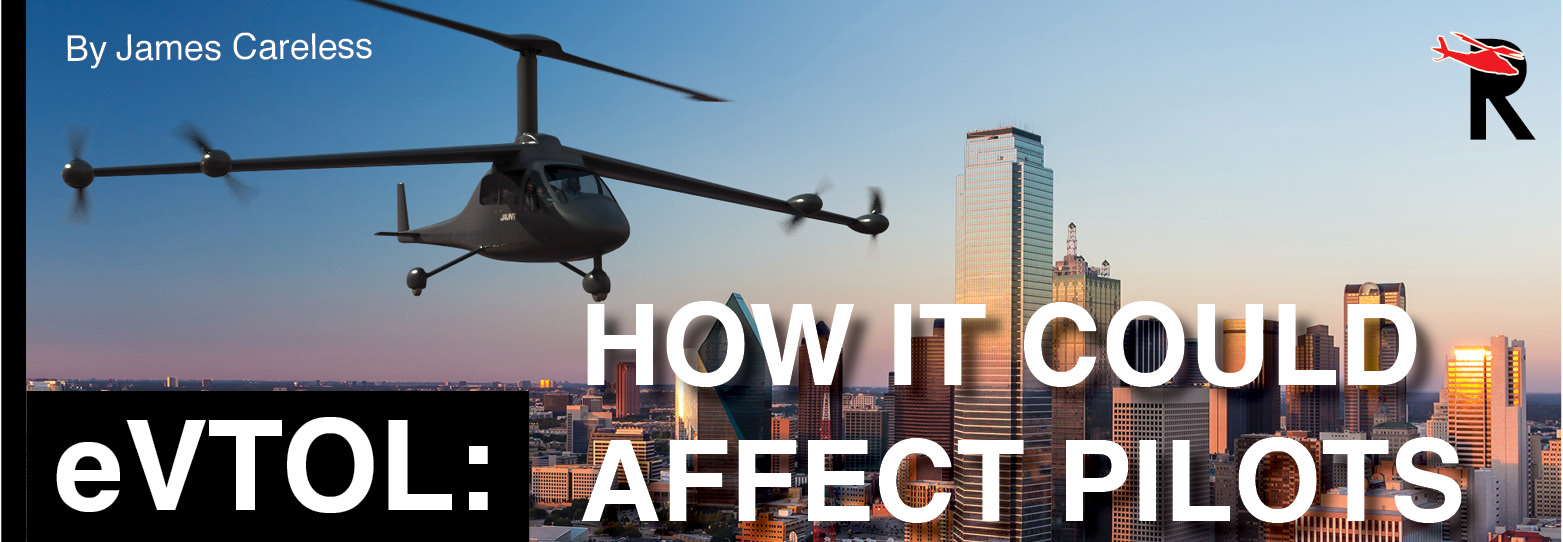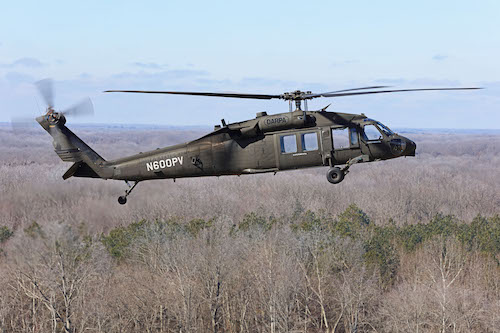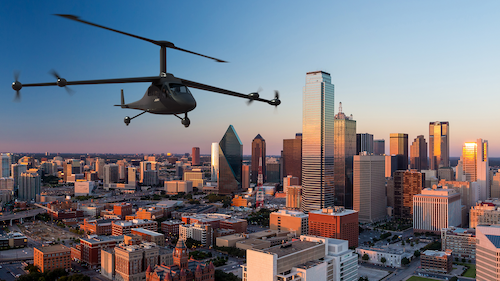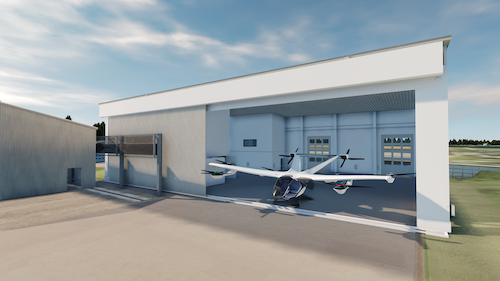|
Dec
12
2022
|
|
Posted 3 years 3 days ago ago by Admin
|
|

The future looks bright for electric vertical take-off and landing (eVTOL) aircraft, at least for the pioneering companies who invest in this emerging low-cost market now. With their reliance on simpler, smaller, and lower-cost rotorcraft architectures, eVTOLs are poised to open up profitable new markets not currently served by conventional helicopters. These include urban aerial airport shuttles, metro services, and taxis; medical logistics and organ transport; and just-in-time/last mile cargo deliveries.
That’s the message from a White Paper titled, “Helicopter Industry Embraces Electric Flight: How Advanced Air Mobility Creates New Market Opportunity for Today’s Helicopter Operators” by Helicopter Association International (HAI) and NEXA Advisors.
The HAI/NEXA paper contains a second, equally important message: If the existing vertica-llift industry doesn’t match outsiders’ efforts to develop/deploy eVTOL aircraft and applications soon, it could surrender its share of eVTOL markets and revenues to these newcomers.
“Aviation and automotive manufacturers are investing billions in the race to bring these aircraft to market,” the HAI/NEXA white paper observed. “Numerous well-funded aircraft development projects are flying large or full scale prototypes today with multiple designs years into certification programs with the FAA and European Union Aviation Safety Agency (EASA). More than one company expects to certify an aircraft by 2023.”
The perception that many eVTOLs will only need pilots with basic flying skills – or no pilots at all! – have raised concerns among the helicopter community. Are pilots in danger of seeing their jobs eventually go the way of human elevator operators? Or will the advent of eVTOLs preserve the most demanding flying jobs for human pilots, and leave the dull stuff to the robots? Here’s what the experts have to say…
An Opportunity, Not a Death Knell

When it comes to the impact of eVTOLs on the existing rotorcraft industry, HAI President and CEO James Viola is quick to characterize their emergence as an opportunity to be embraced, rather than a portent of doom to be feared.
“Let me be clear: AAM (Advanced Air Mobility unmanned aircraft) and eVTOL operations are complementary to conventional helicopters,” Viola told Rotorcraft Pro. “As a result, during the introduction of AAM and eVTOL technology, helicopters will still need to conduct the same missions they are currently performing – and have been performing for over 80 years. Then, as technology advances, we will still need helicopters for specific missions, such as heavy-lift utility work or hot-and-high missions.”
“It’s going to be a totally new world here,” observed Jesse Crispino, chief operations officer with the eVTOL manufacturer Jaunt Air Mobility. “But your traditional turbine engine helicopters are not going anywhere. They're going to have an application for long-haul routes to offshore oil rigs and for the military, just because the range and speed delivered by fossil fuel is so much higher than what can be provided by electric batteries.”
This being said, “unmanned eVTOL will definitely take some share of conventional manned helicopter missions, which obviously implies market share as well,” said Igor Cherepinsky, director of Sikorsky Innovations. But “some” doesn’t mean much.

Airbus Head of UAM Strategy Balkiz Sarihan said, “We believe that eVTOLs will cover only a limited range of potential helicopter missions in the near- and mid-term. This is because batteries do not currently allow eVTOLs to perform SAR, law enforcement or disaster relief missions, for example. So we see shuttle flights for passengers or the medical sector as typical missions for eVTOLs, as well as ecotourism.”
Impact on Jobs
Where will helicopter pilots fit into a Jetsons-like future that has autonomous (self-flying) cargo rotorcraft and eVTOL air taxis buzzing about? Will they be reduced to the role of drone pilots flying their rotorcraft by radio within bunker-like buildings on the ground? Will they have any jobs at all?
This question has been pondered by Danny Sitnam, president and CEO of Helijet International in Richmond, British Columbia, Canada. “We operate North America's largest scheduled point-to-point helicopter service moving over 2.5 million passengers annually between Vancouver, Victoria and Nanimo, and we also provide air ambulance service for the BC government,” he said. “From Helijet’s perspective, we see the emergence of new rotorcraft platforms allowing helicopter pilots and engineers to expand their skills and employment opportunities; eVTOLs and such will expand the job market, not shrink it.”
Speaking as a manufacturer of eVTOLs that will serve as urban air taxis, Jaunt Air Mobility’s Crispino is also optimistic about the future of human helicopter pilots. This is because Jaunt’s eVTOLs are not autonomous: “We need helicopter pilots to fly them,” he said. “Our Jaunt Journey eVTOL is electric and has wings, but it is still a helicopter.”
Sikorsky’s Cherepinsky also sees the development of eVTOLs and other novel rotorcraft as increasing the demand for helicopter pilots, even when autonomous cargo aircraft are factored into the mix. If anything, the general development of more self-directed aircraft will help pilots do their jobs better -- rather than take those jobs from them – by reducing their in-flight workloads through autonomous systems. In this scenario, “the pilot will simply tell the aircraft what to do and the aircraft will do it,” he said.

These positive responses support HAI’s bullish stance on pilots’ job prospects going forward. “I stand by the idea that now is still an exceptional time for people to become helicopter pilots,” said Viola. “As I’ve indicated, helicopters are going to be around for a long time, and we still have a shortage of pilots. This combination provides opportunities for pilots to earn excellent wages and have career advancement opportunities.”
In fact, the employment opportunities offered by the emerging eVTOL sector don’t end with pilots. “Progress in this sector requires a combined effort from professionals in regulation, engineering, and production and a vast amount of employment opportunities will open up,” according to Rob Scholl, CEO of Textron eAviation. “While Textron approaches eVTOL development with a big advantage through our huge installed base of engineering talent across the organization, additional hires will be required as the program develops.” Currently, Textron eAviation is working on the company’s Nexus 4EX eVTOL, which is being built in both all-electric and hybrid electric/gas versions. The company is being aided in its efforts by Textron’s other divisions, including Bell, Textron Aviation, automotive supplier Kautex, and Pipistrel.
“Progress in this sector requires a combined effort from professionals in regulation, engineering, and production and a vast amount of employment opportunities will open up,” according to Rob Scholl, CEO of Textron eAviation.

Challenges to Overcome
The general agreement that eVTOLs will enhance, rather than eviscerate, helicopter career opportunities leads to a logical question: How soon can the rotorcraft industry get to this wonderful new future?
Reports in the mainstream media make it appear that eVTOLs are right around the corner. “No, Really, Flying Taxis Are Getting Close to Takeoff,” claimed a January 22 headline this year on Bloomberg.com. HAI’s Viola is a bit more temperate in his predictions. “While we’re getting closer to remotely piloted aircraft and ultimately autonomous aircraft, it’s not going to happen as fast as the general media might have us believe,” he said. “Certification of these aircraft will take time, particularly with many manufacturers working on concept aircraft. I’ve seen renderings with different rotor configurations and power sources, and each one will need government certification before they begin flying.”
When certification does occur – as it eventually did with earlier forms of revolutionary air transport such as helicopters – the adoption of eVTOLs will not be immediate. “In the beginning, eVTOL services will be either in the public service sector (medical shuttle) or in a dedicated market for passenger transportation,” said Sarihan. “We expect the demand will grow over time as both the technology matures and the market develops to a sustainable and viable size.”
This being said, eVTOLs still have to work out a few things before they can gain greater usage. In particular, the evolving state of eVTOL batteries – namely their peak power performance and storage capacity versus their payload weight and size – remains a key factor in the practicality and profitability of eVTOLs in commercial service. “A lot depends on what happens to the batteries’ ability to store and provide electricity, along with the eVTOL’s power consumption during flight,” said Cherepinsky.
Right now, storing sufficient power for long-enough flights (especially the heavy demand periods of takeoff and landing) remains a concern for advocates of eVTOL flight. Until battery technology evolves to the point of providing more power from smaller packages, this problem puts a limit on eVTOL flight durations and distances–and the demand for pilots to fly them.
On the flip side, any lack of progress in convincing passengers to fly in autonomous aircraft after the FAA and other regulators have signed off on the concept might only boost pilot employment in these aircraft.

“I think you are going to see things like cargo deliveries and search missions start to migrate to smaller, more efficient unmanned vehicles, but it remains to be seen whether our society will accept things like autonomous air taxis,” Cherepinsky observed. “But I don't know that you or I are willing to get into an aircraft that's not flown by anybody. Still, times change: Elevators once had operators in them and people couldn't imagine riding in elevators without operators manning the controls, but now people ride on autonomously controlled elevators without a second thought.”
For his part, Viola thinks the determining factor for public acceptance of eVTOLs will be price. “Will the average consumer initially be able to afford a ride from the airport to a terminal close to home?” he said. “Or will we have to wait while the economies of scale go to work and make flights in these aircraft available to everyone?”
Whatever happens, Viola is unwavering in his faith in eVTOLs and other advances in rotorcraft flight, boosting employment opportunities for pilots, rather than reducing them. “In fact, I think there may be opportunities to retrofit existing helicopters with new eVTOL-based drive systems, extending the lives of the venerable aircraft that brought us to this point,” he said. “Meanwhile, piloted helicopters will not magically disappear within weeks of the first commercial AAM flights. Instead, I expect helicopters to be flying in the skies here for a long time.”
READ MORE ROTOR PRO SEP/OCT ISSUE
READ MORE ROTOR PRO: https://justhelicopters.com/Magazine
WATCH ROTOR PRO YOUTUBE CHANNEL: https://buff.ly/3Md0T3y
You can also find us on
Instagram - https://www.instagram.com/rotorpro1
Facebook - https://www.facebook.com/rotorpro1
Twitter - https://twitter.com/justhelicopters
LinkedIn - https://www.linkedin.com/company/rotorpro1